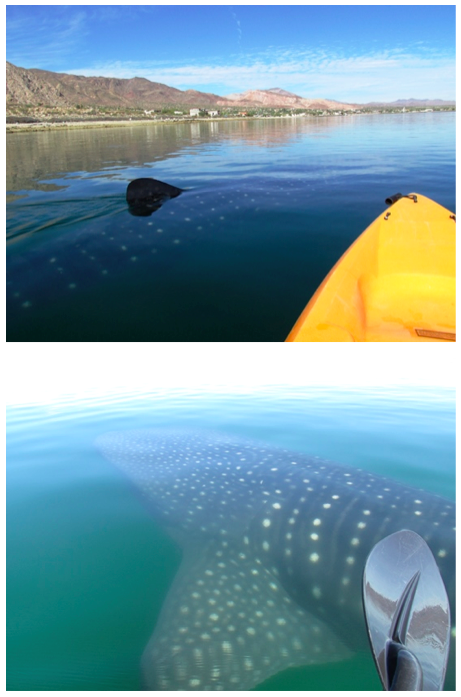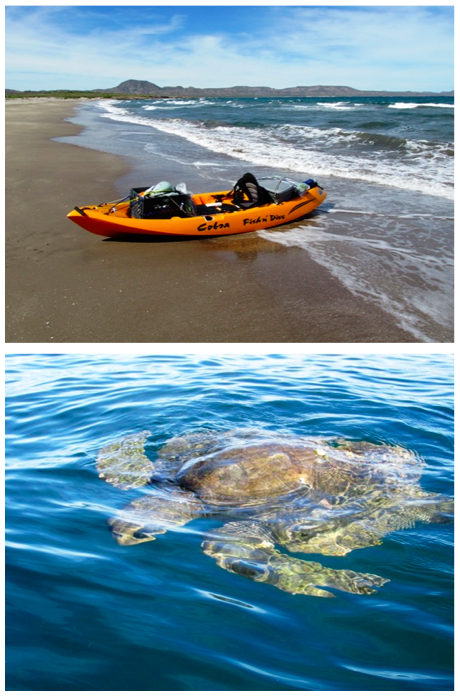Bahía Concepción to San Juanico
By Graham Mackintosh
 The latest stage of my kayaking the Sea of Cortez got off to a great start. I stopped at Bahía de los Ángeles on the way south to check out my “new” kayak and immediately found myself paddling in the company of several docile giant whale sharks. An amazing experience to have them all to myself for over 30 minutes.
The latest stage of my kayaking the Sea of Cortez got off to a great start. I stopped at Bahía de los Ángeles on the way south to check out my “new” kayak and immediately found myself paddling in the company of several docile giant whale sharks. An amazing experience to have them all to myself for over 30 minutes.
Then it was on to Bahía Concepción and Playa Coyote to continue my journey south. I departed Coyote, November 9, where I’d parked my car with friends, then paddled north to Los Naranjos, where my other stage had ended in November 2016. From there it was a shorter crossing to the other side of Bahía Concepción, but I still had 3-4 miles of open water to cross depending how directly I approached the other side.
I left Los Naranjos at 4:30 AM in the dark. It was calm so I angled more towards the mouth of the bay. I crossed Bahía Concepción by the fading light of a lingering old moon, but I could still see bioluminescence as the overloaded sit-on-top moved through the water. The sun was coming up as I made it safely to the other side. Instead of cobble beaches, my route had taken me to a sand beach and I could see the small fish camp of Punta Hornitos ahead approaching Punta Concepción.
Although anxious to exit the bay before the wind came up, I had phone service from Mulegé so I made a few quick last minute phone calls then rounded Punta Concepción glad to finally have the prevailing north wind at my back.
I carried about five days’ supply of water. My satellite Spot device, hand pump desalinator, and the warm sea gave me confidence.
My first protracted stop was at the old Manganese mine a couple of miles outside the bay. I enjoyed looking around at the remains of the buildings. I might have camped on the pebble shore, but it wasn’t yet noon and I didn’t want to stop so early. Everything seemed fine. I was keen to get a good start and have a long paddle on the first day out of the bay.
I was enjoying the delicious feeling of having the beauty of Baja all to myself. As long as the weather was good and the wind was down or moderately from the north I kept going. I had three weeks to make it to Loreto and I was conscious I could lose a week or more if the wind blew for days.
 A little wind from the north helped. Not only did it move me south, it created enough waves to spot the hidden rocks and reefs just offshore. The coast was surprisingly reefy; even paddling 200-300 yards offshore I was occasionally amazed to see dangerous rocks beneath the kayak.
A little wind from the north helped. Not only did it move me south, it created enough waves to spot the hidden rocks and reefs just offshore. The coast was surprisingly reefy; even paddling 200-300 yards offshore I was occasionally amazed to see dangerous rocks beneath the kayak.
For days I saw and spoke to no one. It was just me and the manta rays and the turtles and the fish. What I thought was a person on a beach ahead turned out to be a buck deer with full rack grazing right by the water. That was a Baja first for me.
The Cobra Fish n’ Dive kayak was remarkably stable. I didn’t cut a very elegant figure with the decks so loaded and it would be hard to control in a strong head wind, but my profile was acting like a sail and the wind from the north was doing half the work. Safety for me meant sticking as close to the shore as possible, and being always ready and able to head in and land.
Unless it was calm and flat, I preferred to go ashore as few times as possible, especially on cobble or pebbles. In the evening, I had to dry out the kayak and the gear, make camp, and coyote-proof everything. Experience had taught me coyotes would be around at night and anything not secure in the tent or hatches or bungeed down was likely to be gone in the morning. By the time the day’s work was over, I usually had little energy to fish or cook. A piece of fruit, a couple of cereal bars, a warm beer for a few days, coffee if I had the energy to get a fire going… and I was ready to sleep.
I was typically up and packing at 4:00-5:00 AM, ready to launch close to first light. Paddling in the dark on the outside of Bahía Concepcion was not such a good idea. The hidden reefs were too dangerous. And I saw a scorpion on the kayak while about to launch one morning! Heading north to south was definitely the way to go with the wind, but the downside is you’re paddling in the morning into the sun, half-blinded, and you feel obliged to move even further offshore.
When the wind was from the north and the tides were falling and draining is when I made the most progress. But occasional south winds made for really hard work.
I picked up my first water and had my first conversation at the tiny protected cove of San Sebastian. I recalled walking in there in 1984. Memories came flooding back. But now, instead of trailers and humble homes really nice houses ringed the beach.
Late afternoon, I paddled on to the Mexican fishing community of San Nicolás. The wind and the seas picked up. The kayak was being thrown around in the waves, which occasionally came breaking over the deck. I could see the palm trees and the inviting sand ahead. The landing was going to be through the surf and wet. I passed a couple of outlier fish camps and landed near the lagoon in the main village, a hundred yards from the pangas lined up on the beach.
The friendly fishermen offered slightly contradictory advice—one wasn’t going to fish next day as he thought it too windy, another thought it would calm down in the afternoon. I was left alone and slept well on the broad sandy beach.
I was in no hurry to leave the next day. Mid-morning, I launched into surf and white caps hoping it would calm down. It didn’t. If there weren’t beaches on shore in Bahía San Nicolás I wouldn’t have launched. After two miles, with the wind howling, I had to go ashore or risk rolling the kayak. White caps gave way to breaking waves as I paddled in. I surfed ashore onto a sandy beach and as quickly as possible got the loaded kayak beyond the waves.
The beach was wide and sandy, but it was fine sand that blew easily in the strong wind, covering everything. I unloaded the kayak to dry out and kept my gear on a tarp at the high tide line on the heavier, wetter sand.
As the wind eased near dark I managed to get the tent pegged and most of my gear inside. I was anxious not to be stuck on this shadeless north-facing beach.
Although conditions were far from ideal, I was packed and ready at dawn. The seas were still scary. But the wind was sure to pick up. I watched the waves for 15 minutes and got a sense of the pattern of the biggest sets. Even so, when I pushed the kayak through the waves I was swamped, and wet, but happy I hadn’t overturned and was soon paddling beyond the breakers.

I soon rounded rocky Punta San Antonio. And shortly afterwards faced the awesome mass of Punta Pulpito. If I could get beyond that I’d be relatively sheltered and safe. I paddled toward it with the early sun in my face. It was hard to see, and I had to move out to minimize the chance of running onto a rock or reef. Deserving of the utmost respect, Punta Pulpito had been staring me in the face for days. Kayakers had died beneath its towering mass.
Slowly I made the turn, and just as I thought I was protected, I found myself dealing with a powerful headwind on the other side. There were two sailboats at anchor. I slowly paddled towards the bigger of the two. I was able to top up with water and get information from a catamaran off to the South Seas.
Just south of Pulpito, I saw a lovely canyon with a narrow beach entrance. I was able to float and drag the kayak over smooth rock at high tide and unload in beautiful protected seclusion; my plan was to leave the following morning during the high tide. According to the sailboaters – there should be just moderate winds the next day.
After a peaceful night, I was ready at first light. Feeling good with all my water and a reliable wind forecast, I ran directly from Pulpito six or seven miles to the beautiful anchorage and bay of San Juanico (San Basilio). Halfway there, I found myself about two miles from shore, and as the wind picked up became increasingly nervous about that distance. I angled closer.
The wind as I approached San Juanico became really strong… really too strong for my kayak. Even though the wind was from the north and I was whizzing along, it was tiring continually surfing the waves and trying to keep the kayak pointing in the right direction using the paddle as a rudder.
I was glad to pull into the shelter of the famed bay. Suddenly, it was so calm, and spacious inside. There were large houses, beautiful islands, beaches, a shrimp boat and sailboat at anchor. San Juanico is one of the treasures of Baja. After chatting with the sailboater, I camped on a lovely shell beach with early shade and no road access.
Back in 1984, I thought the bay looked wonderful. I promised I’d be back. Well, it took me 33 years, and in spite of the houses I wasn’t disappointed. It seemed back then that the line of rocks at the south end – Punta Mercenarios – looked like those at Cabo. I still had that impression.
I was exhausted but I’d made it, and even though tomorrow was forecast to be fine I took my first day off and attended to necessary chores like trying to stem a few leaks on top of the kayak. It was too beautiful to go anywhere. As well as caulking the hatches and the rod holders, I explored, photographed, and paddled around the vast bay. San Juanico is a place you may not want to leave.
